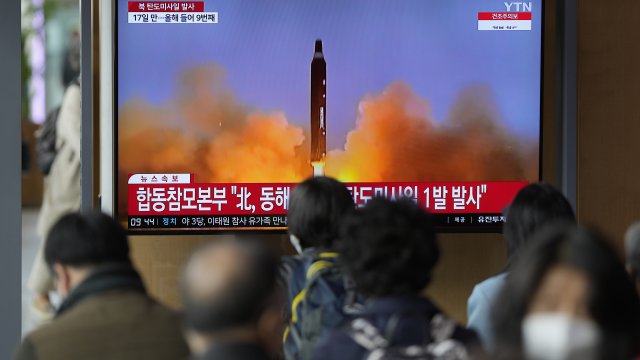North Korea on Thursday conducted its first intercontinental ballistic missile launch in a month, possibly testing a new more mobile, harder-to-detect missile for the first time, its neighbors said, as it extends its provocative run of weapons tests.
Japan briefly urged residents on a northern island to take shelter in an indication of its vigilance over North Korea's evolving missile threats.
The missile was launched on a high angle from near the North Korean capital of Pyongyang and fell in the waters between the Korean Peninsula and Japan following a 620-mile flight, South Korea’s Joint Chiefs of Staffs said in a statement.
It described its range as medium or longer. The U.S. National Security Council called it a long-range missile and Japan’s government said it likely had an intercontinental range.
South Korea’s military believes North Korea launched a new type of ballistic missile, possibly using solid fuel, a defense official said under the condition of anonymity because of office rules.
If the launch involved a solid-fuel ICBM, it would be the North’s first test of such a weapon. North Korea’s known ICBMs all use liquid propellants that must be fueled before launches. But the fuel in a solid-propellant weapon is already loaded, allowing it to be moved easier and fired faster.
A solid-fuel ICBM is one of the key high-tech weapons that North Korean leader Kim Jong Un has vowed to build to better cope with what he calls U.S. military threats. He also wants a multiwarhead missile, a nuclear-powered submarine, a hypersonic missile and a spy satellite.
SEE MORE: Should we be nervous about North Korea's nuclear weapon tests?
During an emergency meeting of Seoul's National Security Council, officials stressed the need to tighten three-way security cooperation with Washington and Tokyo. Japanese Prime Minister Fumio Kishida held a meeting of his NSC to analyze the launch and Japan’s response.
The nuclear envoys of Seoul, Washington and Tokyo held a telephone conversation where they called for a “decisive and united international response” to North Korean provocations and stronger efforts to stem illicit North Korean funding of its weapons program.
North Korea commonly test-launches missiles toward the international waters between the Korean Peninsula and Japan, using elevated trajectories to avoid neighboring countries. South Korea and Japan typically don’t issue evacuation orders unless they determine the North Korean weapon is flying in their direction.
Japanese Defense Minister Yasukazu Hamada told reporters the North Korean missile launched Thursday did not reach Japan’s exclusive economic zone. But Japanese authorities still urged people on the northernmost island of Hokkaido to seek shelter and temporarily suspended train, bus and subway services there. Local communities also activated alert sirens through community speakers, urging people to evacuate.
The government then retracted its missile alert, saying there was no possibility of the missile landing near Hokkaido. Chief Cabinet Secretary Hirokazu Matsuno told reporters the alert was based on the Japanese Defense Ministry’s early assessment of the missile’s path and was an “appropriate” step to prioritize people’s safety.
Japanese authorities issued a similar evacuation order in October when a North Korean intermediate-range missile flew over Japan in a launch that demonstrated the weapon's potential to reach the U.S. Pacific territory of Guam.
SEE MORE: Kim Jong Un's sister warns North Korea ready to act against US, SKorea
Thursday’s launch was the North’s first long-range missile firing since the country tested its longest-range, liquid-fueled Hwasong-17 ICBM on March 16. Kim Jong Un reviewed his country’s attack plans Monday and vowed to enhance his nuclear arsenal in more “practical and offensive” ways.
North Korea has launched about 100 missiles since the start of 2022, many of them nuclear-capable weapons that place the U.S. mainland, South Korea or Japan within striking distance.
The North’s testing spree is largely in protest of South Korean-U.S. military drills that it views as a rehearsal for an invasion. Some observers say North Korea uses its rivals' drills as a pretext to modernize its weapons arsenal and pressure Washington and Seoul to make concessions such as the lifting of economic sanctions. South Korean and U.S. officials say their drills are defensive in nature and were arranged to respond to North Korea's growing nuclear and missile threats.
Later Thursday, China, North Korea’s last major ally, reiterated its blame for the heightened animosities on the U.S. and South Korea.
“The negative impact of the U.S. military exercises and strategic weapons deployed around the peninsula a few days ago is obvious to all,” Foreign Ministry spokesperson Wang Wenbin said in a briefing.
Trending stories at Scrippsnews.com



